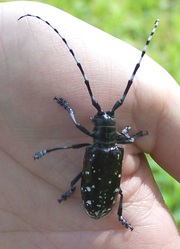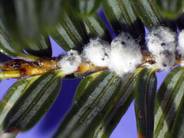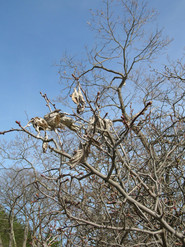Invasive Pest Outreach Information
The emerald ash borer (EAB) is considered one of the most serious threats to our nation's forests and urban landscape. All native ash trees in the U.S. are susceptible to attack and mortality by the emerald ash borer. Since it's discovery 15 years ago in Michigan, the emerald ash borer has killed hundreds of millions of ash trees, leaving large gaps in the forest landscape and many city streets bare. Because of how quickly EAB has spread throughout the country, eradication is not possible. Current management strategies include biocontrol, developing resistance in trees, slowing the spread, and tons of outreach and education.
-
New State Finds:
Since the beginning of summer, the emerald ash borer was found in three more states; Texas (in May), Nebraska (in June), and Delaware (in August). That brings the total state count to 28. To date, emerald ash borer has not been found in Maine.
-
Why has emerald ash borer not been found in Maine?
Are "they" looking for it? The answer is YES! The federal government, the state government, and various cooperators have employed all the surveillance tools known to us to help detect emerald ash borer in the state. This year the USDA contracted with Delta-21 to deploy over 800 purple traps, and the Maine Forest Service conducted biosurveillance and organized the trap tree network to help detect early introductions of EAB. The state has conducted numerous trainings to industry, public works, educators, and landowners to teach signs of an EAB infestation. With all these EAB detection activities, the emerald ash borer has not been found in Maine. If you suspect you have seen EAB or signs of an infestation, please take pictures and make a report here.
-
Quarantines:
The existence of emerald ash borer in a state means that the state is either partially or entirely quarantined. If you are considering moving wood (including firewood), check the quarantine map to determine if you need a permit. If you are moving wood within a state that is partially quarantined, you may need a permit. Please be aware that Massachusetts is fully quarantined, and New Hampshire is partially quarantined. Firewood from anywhere in Massachusetts and parts of NH (as well as many other states) should not enter Maine without a permit, or the federal quarantine will be violated.
-
Firewood Scout:
In an effort to comply with state bans on out-of-state firewood, Maine is preparing to join Firewood Scout - an online resource to help campers find and buy firewood close to their destination. There is no cost to the user or participating vendors. If you are a firewood vendor and would like to be found on this network, please send an email to BugWatchME.AGR@maine.gov
-
Latest EAB Research:
Discovering what makes up an EAB-resistant ash tree - Entomology Today
Can we manipulate EAB's "vision" so they are unable to find a mate? - Daily Herald
A tiny parasitic wasp from Russia approved as another biocontol agent for EAB - University of Delaware
Females shocking males: implications for early detection of EAB - Total Landscape Care
-
Emerald Ash Borer Universiy:
Would you like more in-depth information about emerald ash borer biocontrol, or how firewood movement is a threat to our forests, or...? Check out these amazing educational videos on at EABU on YouTube.
 The Asian longhorned beetle (ALB) is another invasive forest pest that Maine is concerned about. Unlike the emerald ash borer, ALB can be eradicated and has been successfully eradicated from a number of areas in the U.S. Now the ALB is known in only 3 states - Massachusetts, New York, and Ohio. Eradication programs are ongoing in these states and Canada, with the goal of eliminating this beetle from North America.
The easiest way to know if you have Asian longhorned beetle is to notice the adult beetle. In fact, most of the North American detections have been reported by the general public who noticed an unusually large beetle. The best time to look for the adult beetle in Maine is during its estimated emergence range for our state - mid-July thru early October. So, it's not too late to spot the beetle. If you do, don't forget to capture it or photograph it and make a report! www.maine.gov/alb
Here's a helpful guide to identifying the beetle and other signs of an infestation.
|
 |
|
Hemlock Woolly Adelgid
The hemlock woolly adelgid continues to slowly spread through southern and coastal Maine, with recent detections being spotted on Frye Island and Standish. According to the Maine Forest Service, August through February is the best time to work in hemlocks from the standpoint of minimizing the risk of introducing or spreading HWA. |
 Browntail Moth
Browntail moth is not only a serious tree defoliator, it is a human health hazard as its toxic hairs can cause severe rashes. This year, the range of browntail moth has expanded beyond the few communities in southern and coastal Maine and has been reported as far east as Roque Bluffs and inland to Waterville.
Do you wonder if browntail moth is in your community? Now is a good time to do some surveillance. Look for its winter nests, which are starting to form at the tips of oak and apple. These webbed nests harbor the young caterpillars that will overwinter. Don't be confused with the fall webworm webs that seem to be quite prevalent in parts of Maine right now. Browntail Moth Winter Nests vs. Fall Webworm Webs. Browntail moth winter webs should be clipped off and destroyed to reduce its populations.
|
Interested in more updates about forest insects and diseases? Check out the
Forest Insect & Disease Conditions Reports from the Maine Forest Service
Would you like to provide feedback on this newsletter, or do you have questions or comments? Email BugWatchME.AGR@maine.gov
|